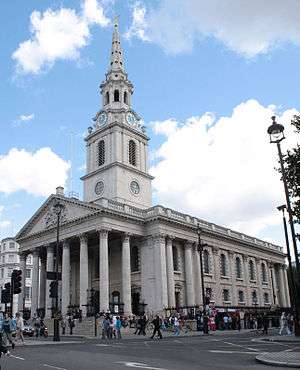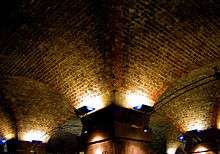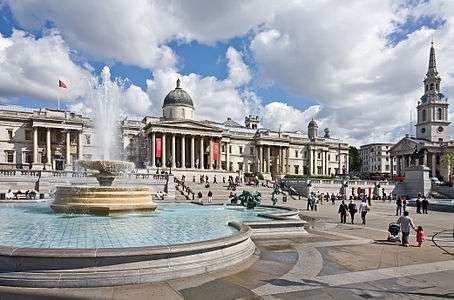St Martin-in-the-Fields
| St Martin-in-the-Fields | |
|---|---|
 2011 | |
| Location |
Westminster London, WC2 |
| Country | England |
| Denomination | Church of England |
| Website |
www |
| History | |
| Dedication | Saint Martin |
| Architecture | |
| Status | Parish church |
| Functional status | Active |
| Heritage designation | Grade I |
| Architect(s) | James Gibbs |
| Architectural type | Church |
| Style | Neoclassical |
| Years built | 1721–1726 |
| Specifications | |
| Number of spires | 1 |
| Spire height | 192 feet (59 m) |
| Bells | 12 (full circle) |
| Tenor bell weight | 29 long cwt 1 qr 1 lb (3,277 lb or 1,486 kg) |
| Administration | |
| Deanery | Westminster (St Margaret) |
| Archdeaconry |
London (previously Charing Cross) |
| Diocese | London |
| Province | Canterbury |
| Clergy | |
| Vicar(s) | Sam Wells |
| Laity | |
| Director of music | Andrew Earis PhD[1] |
| Churchwarden(s) |
Gail Elkington Adrian Harris |
Listed Building – Grade I | |
| Official name: Church of St Martin in the Fields | |
| Designated | 24 February 1958 |
| Reference no. | 1217661[2] |
St Martin-in-the-Fields is an English Anglican church at the north-east corner of Trafalgar Square in the City of Westminster, London. It is dedicated to Saint Martin of Tours. There has been a church on the site since the medieval period. The present building was constructed in a Neoclassical design by James Gibbs in 1722–1726.
History
Roman era
Excavations at the site in 2006 led to the discovery of a grave from about 410 AD.[3] The site is outside the city limits of Roman London (as was the usual Roman practice for burials) but is particularly interesting for being so far outside, and this is leading to a reappraisal of Westminster's importance at that time. The burial is thought by some to mark a Christian centre of that time (possibly reusing the site or building of a pagan temple).

Medieval and Tudor
The earliest extant reference to the church is from 1222, with a dispute between the Abbot of Westminster and the Bishop of London as to who had control over it. The Archbishop of Canterbury decided in favour of Westminster, and the monks of Westminster Abbey began to use it.[4]
Henry VIII rebuilt the church in 1542 to keep plague victims in the area from having to pass through his Palace of Whitehall. At this time, it was literally "in the fields", an isolated position between the cities of Westminster and London.
Seventeenth century
By the beginning of the reign of James I, the church had become inadequate for the size of its congregation, due to the great increase in population in the area. In 1606 the king granted an acre of ground to the west of St. Martin's Lane for a new churchyard,[5] and the building was enlarged eastwards over the old burial ground, increasing the length of the church by about half.[6] At the same time the church was, in the phrase of the time, thoroughly "repaired and beautified".[6] Later in the 17th century capacity was further increased with the addition of galleries. The creation of the new parishes of St Anne, Soho, and St James, Piccadilly and the opening of a chapel in Oxenden Street also relieved some of the pressure on space.[5]
As it stood at the beginning of the 18th century, the church was built of brick, rendered over, with stone facings. The roof was tiled, and there was a stone tower, with buttresses. The ceiling was slightly arched,[6] supported with what Edward Hatton described as "Pillars of the Tuscan and Modern Gothick orders".[6] The interior was wainscotted in oak to a height of 6 ft (1.8 m), while the galleries, on the north, south and west sides, were of painted deal.[6] The church was about 84 ft (26 m) long and 62 ft (19 m) wide. The tower was about 90 ft (27 m) high.[6]
A number of notables were buried in this phase of the church, including Robert Boyle, Nell Gwynne, John Parkinson and Sir John Birkenhead.
Rebuilding

A survey of 1710 found that the walls and roof were in a state of decay. In 1720, Parliament passed an act for the rebuilding of the church allowing for a sum of up to £22,000, to be raised by a rate on the parishioners. A temporary church was erected partly on the churchyard and partly on ground in Lancaster Court. Advertisements were placed in the newspapers that bodies and monuments of those buried in the church or churchyard could be taken away for reinterment by relatives.[5]

The rebuilding commissioners selected James Gibbs to design the new church. His first suggestion was for a church with a circular nave and domed ceiling,[7] but the commissioners considered this scheme too expensive. Gibbs then produced a simpler, rectilinear plan, which they accepted. The foundation stone was laid on 19 March 1722, and the last stone of the spire was placed into position in December 1724. The total cost was £33,661 including the architect's fees.[5]
The west front of St Martin's has a portico with a pediment supported by a giant order of Corinthian columns, six wide. The order is continued around the church by pilasters. In designing the church, Gibbs drew upon the works of Christopher Wren, but departed from Wren's practice in his integration of the tower into the church. Rather than considering it as an adjunct to the main body of the building, he constructed it within the west wall, so that it rises above the roof, immediately behind the portico,[7] an arrangement also used at around the same time by John James at St George, Hanover Square (completed in 1724), although James' steeple is much less ambitious.[7] The spire of St Martin's rises 192 ft (59 m) above the level of the church floor.[5]
The church is rectangular in plan, with the five-bay nave divided from the aisles by arcades of Corinthian columns. There are galleries over both aisles and at the west end. The nave ceiling is a flattened barrel vault, divided into panels by ribs. The panels are decorated in stucco with cherubs, clouds, shells and scroll work, executed by Giuseppe Artari and Giovanni Bagutti.[5]
Until the creation of Trafalgar Square in the 1820s, Gibbs's church was crowded by other buildings. J.P. Malcolm, writing in 1807, said that the its west front "would have a grand effect if the execrable watch-house and sheds before it were removed" and described the sides of the church as "lost in courts, where houses approach them almost to contact".[8]
The design was criticised widely at the time, but subsequently became extremely famous, being copied particularly widely in the United States.[9] In Britain, the design of the 1830s St Andrew's in the Square church in Glasgow was inspired by it. In India, St. Andrew's Church, Egmore, Madras (now Chennai) is modelled on St Martin-in-the-Fields.
Various notables were soon buried in the new church, including the émigré sculptor Louis-François Roubiliac (who had settled in this area of London) and the furniture-maker Thomas Chippendale (whose workshop was in the same street as the church, St Martin's Lane[10]), along with Jack Sheppard in the adjoining churchyard. This churchyard, which lay to the south of the church, was removed to make way for Duncannon Street, constructed in the 19th century to provide access to the newly created Trafalgar Square.[11]
Before embarking for the Middle East Campaign, Edmund Allenby was met by General Beauvoir de Lisle at the Grosvenor Hotel and convinced General Allenby with Bible prophecies of the deliverance of Jerusalem. He told General Allenby that the Bible said that Jerusalem would be delivered in that very year, 1917, and by Great Britain. General Beauvoir de Lisle had studied the prophecies, as he was about to preach at St Martin-in-the-Fields.[12]
Recent times

Because of its prominent position, St Martin-in-the-Fields is one of the most famous churches in London. Dick Sheppard, Vicar from 1914 to 1927 who began programmes for the area's homeless, coined its ethos as the "Church of the Ever Open Door". The church is famous for its work with young and homeless people through The Connection at St Martin-in-the-Fields,[13] created in 2003 through the merger of two programmes dating at least to 1948. The Connection shares with The Vicar's Relief Fund the money raised each year by the BBC Radio 4 Appeal's Christmas appeal.[14]
The crypt houses a café which hosts jazz concerts whose profits support the programmes of the church. The crypt is also home to the London Brass Rubbing Centre, an art gallery and a book and gift shop. A life-sized marble statue of Henry Croft, London's first pearly king, was moved to the crypt in 2002 from its original site at St Pancras Cemetery.
In January 2006, work began on a £36-million renewal project. The project included renewing the church itself, as well as provision of facilities encompassing the church's crypt, a row of buildings to the north and some significant new underground spaces in between. The funding included a grant of £15.35 million from the Heritage Lottery Fund. The church and crypt reopened in the summer of 2008.[4]
Twelve historic bells from St Martin-in-the-Fields, cast 1725, are included in the peal of the Swan Bells tower in Perth, Western Australia. The current set of twelve bells, cast in 1988, which replace the old ones are rung every Sunday between 9am and 10am by the St Martin in the Fields Band of Bell Ringers[15]
Royal connections
The church has a close relationship with the Royal Family, whose parish church it is,[16] as well as with 10 Downing Street and the Admiralty.[17]
Almshouses
The church established its own almhouses and pension-charity on 21 September 1886. The 19 church trustees administered almshouses for women and provided them with a weekly stipend. The almshouses were built in 1818 on part of the parish burial ground in Camden Town and St Pancras and replaced those constructed in 1683.[18]
Vicars
|
|
Music
The church is known for its regular lunchtime and evening concerts: many ensembles perform there, including the Academy of St Martin-in-the-Fields, which was co-founded by Sir Neville Marriner and John Churchill, a former Master of Music at St Martin's.
List of organists

Organists include:
- John Weldon 1714–1736
- Joseph Kelway 1736–1781 (formerly organist of St Michael, Cornhill)
- Benjamin Cooke 1781–1793
- Robert Cooke 1793–1814 (son of Benjamin Cooke)
- Thomas Forbes Gerrard Walmisley 1814–1854?
- William Thomas Best 1852–1855?
- W.H. Adams, appointed 1857
- H.W.A. Beale
- William John Kipps 1899–1924
- Martin Shaw 1920–1924
- Arnold Goldsborough 1924–1935
- John Alden 1935–1938
- Stanley Drummond Wolff 1938–1946
- John Churchill 1949–1967
- Eric Harrison 1967–1968
- Robert Vincent 1968–1977 (later organist of Manchester Cathedral)
- Christopher Stokes 1977–1989 (later Director of Music, St. Margaret's Westminster Abbey and Organist & Master of the Choristers Manchester Cathedral)
- Mark Stringer 1989–1996 (currently Director of Music, Wells Cathedral School, Wells UK, since April 2015; Executive Director Trinity College London, 1997-2012; sometime Director of Music, Methodist Central Hall, Westminster)
- Paul Stubbings 1996–2001 (later Director of Music, St Mary's Music School, Edinburgh)
- Nick Danks 2001–2008
- Andrew Earis 2009 –
St Martin's school
In 1699 the church founded a school for poor and less fortunate boys, which later became a girls' school. It was originally sited in Charing Cross Road, near the church. At one time it was known as St Martin's Middle Class School for Girls, and was later renamed St Martin-in-the-Fields High School for Girls. It was relocated to its present site in Lambeth in 1928.
The school badge depicts the eponymous St Martin of Tours. The school's Latin motto Caritate et disciplina translates as "With love and learning".[9] The school is Christian but accepts girls of all faiths.
See also
- Christ Child (sculpture) (1999)
- Academy of St Martin in the Fields
- List of churches and cathedrals of London
Notes and references
- ↑ "An interview with Andrew Earis". stmartin-in-the-fields.org. 27 October 2015.
- ↑ Historic England. "Details from listed building database (1217661)". National Heritage List for England. Retrieved 22 November 2016.
- ↑ "Ancient body prompts new theories". BBC News. BBC.co.uk. 1 December 2006. Retrieved 15 January 2014.
- 1 2 At the heart: The Renewal of St. Martin-in-the-fields (PDF). St Martin-in-the-Fields. 2006. Retrieved 15 January 2014.
- 1 2 3 4 5 6 7 8 9 10 Gater, G.H.; Hiorns, F.R., eds. (1940). "Appendix: Vicars of St. Martin-in-the-Fields". Survey of London: volume 20: St Martin-in-the-Fields, part III: Trafalgar Square & Neighbourhood. London County Council. pp. 31–54, 128. Retrieved 15 January 2014 – via British History Online.
- 1 2 3 4 5 6 Hatton, Edward (1708). "St. Martin's Church (in the fields)". A New Picture of London. 1. London. pp. .340 et seq.
- 1 2 3 Summerson, John (1970). Architecture in Britain, 1530 to 1830. Pelican History of Art. Harmondsworth: Penguin Books. pp. 309–353. ISBN 978-0-14-056103-6.
- ↑ Malcolm, James Peller (10 June 1807). Londinium Redivivium, or, an Ancient History and Modern Description of London. 4. London. p. 202. Retrieved 15 January 2014.
- 1 2 Sheppard, Francis (2000). London: a history. Oxford: Oxford University Press. p. 240. ISBN 0-19-285369-4.
- ↑ When built the church faced into on St Martin's Lane; and it was only much later, with the construction of Trafalgar Square, that it attained the prominence that it has today.
- ↑ For the planning of Duncannon Street see Mace, Rodney (1975). Trafalgar Square: Emblem of Empire. London: Lawrence & Wishart. p. 36. ISBN 0-85315-367-1.
- ↑ Novak, Fr. Victor (7 December 2012). "AS BIRDS FLYING, The Miracle of December 8th". Frnovak.blogspot.com. Retrieved 16 November 2013.
- ↑ "History". The Connection at St-Martin-in-the-fields. Retrieved 15 January 2014.
- ↑ "History". St Martin-in-the-Fields. Retrieved 15 January 2014.
- ↑ "St Martin in the Fields Band of Bell Ringers Website". St Martin in the Fields Band Of Bell Ringers. Retrieved 10 February 2015.
- ↑ King George I was a churchwarden and Queen Mary attended services regularly.
- ↑ This falls within its parish, and the Trafalgar Square link strengthens the bond — the church flies the White Ensign of the Royal Navy rather than the Union Flag, and traditionally the church bells are rung to proclaim a naval victory.
- ↑ "London Family History: St Martin-in-the-Fields". Archived from the original on 20 August 2011. Retrieved 28 January 2014.
- ↑ "Humphry, William Gilson (HMHY832WG)". A Cambridge Alumni Database. University of Cambridge.
- ↑ Beeson, Trevor (30 November 2007). Round the Church in 50 Years: A Personal Journey. London: SCM Press. p. 149. Retrieved 15 January 2014.
- ↑ "New Bishop of Salisbury Announced" (Press release). Church of England. 13 April 2011. Retrieved 15 January 2014.
External links
| Wikimedia Commons has media related to St Martin-in-the-Fields. |
- St Martin-in-the-Fields website
- Connection at St Martin's website
- Roman occupation of church site
- Mystery Worshipper Report at the Ship of Fools website
- Deanery of Westminster (St Margaret)
Coordinates: 51°30′32″N 0°07′37″W / 51.50889°N 0.12694°W
